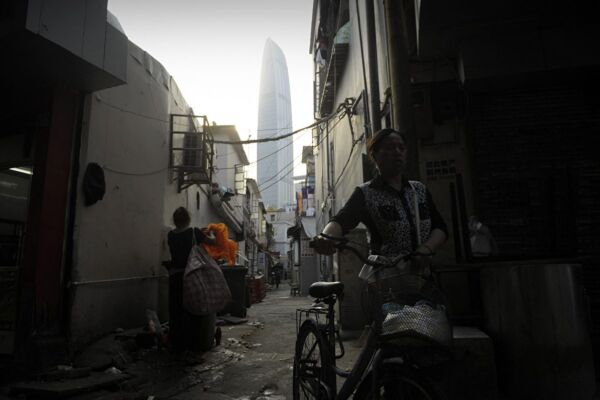According to the latest research, the prices of second-hand homes in China’s top 100 cities have been continuously declining for over 3 years, with an average year-on-year drop of over 7%. Analysts believe that various reasons have led to a general lack of optimism in the real estate market, with actual housing demand being weak. It is expected that both second-hand and new housing prices will continue to fall, indicating that the Chinese property market has yet to hit rock bottom.
A recent research report released by the China Index Research Institute on September 1st revealed that the average price of second-hand homes in China’s top 100 cities in August was 13,481 RMB per square meter, showing a 7.34% year-on-year decrease and a 0.76% decrease from the previous month, marking a continuous downward trend for 40 months.
First-tier cities performed slightly better than second, third, and fourth-tier cities. In first-tier cities, the prices of second-hand homes dropped by 4.17% year-on-year and 0.55% month-on-month; in second-tier cities, the year-on-year decline was 8.14% with a 0.85% monthly decrease; while the third and fourth-tier cities saw a 7.78% year-on-year drop and a 0.78% monthly decrease.
Professor Xie Tian from the Darla Moore School of Business at the University of South Carolina told a reporter that housing demand in first-tier cities comes from all over the country and overseas, making their demand relatively strong. When real estate market bubbles burst, it usually starts from economically weaker regions.
“When first-tier cities struggle, it signals a very serious situation. We are already beginning to see this in first-tier cities, so the overall situation is very grim,” he added.
In August, new housing prices in China saw a slight increase, but property developers’ sales performance showed a downward trend, indicating a lack of real market demand.
The average price of new homes in China rose by 2.73% year-on-year to 16,910 RMB per square meter in August, with a 0.20% increase from the previous month. Among them, the year-on-year increase in new home prices in first-tier cities was 6.88%, with a monthly increase of 0.48%.
This was partly due to some cities rolling out new housing policies. Recently, Beijing and Shanghai allowed qualified buyers to purchase homes outside the fifth ring road in Beijing and outside the outer ring road in Shanghai without restrictions on the number of units; Suzhou lifted sales restrictions; Guangxi relaxed price restrictions and introduced low-monthly-payment financial products.
However, from January to August this year, sales of the top 100 real estate enterprises in China dropped by 13.3% year-on-year to approximately 2.3 trillion RMB, maintaining the same decline rate as from January to July.
Data released by the CRIC Research Center under E-house China on August 31st also showed that sales transaction amounts of the top 100 real estate enterprises in China have been declining for six consecutive months. In August, this amount was approximately 207 billion RMB, down by 17.6% year-on-year and 1.9% from the previous month.
It seems that the effects of the “new housing policies” have not been evident in sales data. Economic analyst David Huang mentioned that the scope of the policies is relatively limited, only focusing on areas outside the fifth ring road in Beijing and beyond the outer ring road in Shanghai, limiting their impact to a relatively small group of buyers. Additionally, an oversupply of second-hand homes has led to increased listings and larger discounts, creating competition for new homes in the same cities.
He emphasized that market confidence is crucial, stating that overall market confidence is very weak, with dim outlooks on future expectations, economic performance, incomes, and other aspects, leading to a lack of confidence.
The Chinese real estate market typically experiences peak sales in September and October, known as the “Golden September, Silver October” period. However, it is uncertain whether this trend will continue optimistically this year.
David Huang suggested that with frequent “new housing policies” in place, there may be structural rebounds in core cities in the Pearl River Delta, Yangtze River Delta, and the Beijing-Tianjin-Hebei region. Yet, due to the lack of “comprehensive improvement signals,” with financing and investment channels remaining subdued, prices in other medium-sized cities may continue to lag.
A report released by the renowned investment bank Goldman Sachs in late June predicted a further 10% decline in Chinese property prices by 2027, following a 20% decline over the past 4 years. Huang noted that Goldman Sachs’ assessment primarily focuses on core cities and regions, rather than the national real estate market as a whole.
He pointed out that the Chinese property market demonstrates significant regional disparities, with regions like the Pearl River Delta, Yangtze River Delta, and Beijing-Tianjin-Hebei showing relatively better conditions. Whereas other domestic cities, especially inland areas, may face more severe challenges, potentially seeing declines surpassing 10% by 2027, with varying degrees of differentiation.
According to mainland financial media reports, in 2024, housing prices in 25 provinces in China plummeted to “cabbage prices,” with a unit selling for only tens of thousands of RMB. This scenario is more prevalent in resource-scarce medium-sized cities, with Hegang City in Heilongjiang Province being a key example.
Professor Xie Tian also believes that the Chinese property market is unlikely to reach its bottom anytime soon, drawing comparisons to Japan’s real estate collapse history.
Following the bursting of the property bubble in 1991, Japan witnessed nearly 20 years of declining property prices, hitting bottom in 2009 with an average drop of over 45%. Tokyo’s situation varied, with property prices bottoming out earlier around 2002 but still experiencing a significant 53% decrease.
Xie Tian highlighted the enormous bubble in China’s real estate market, stating that predicting the market’s stabilization within 3 to 4 years or 4 to 5 years is uncertain and risky.

